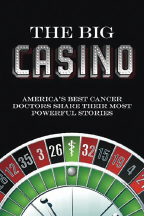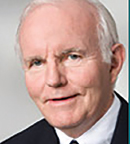Many Type A personalities deal with problems by controlling all aspects of the problem. Sometimes this works. Sometimes it works for a while. Sometimes it doesn’t work at all. The health-care system—hospitals, clinics, and doctors’ offices—have policies (specific office hours and strict appointment times) based on controlling the interactions between doctors and patients. When a controlling patient meets a controlling medical-care system, the results are not always what one may have anticipated.
Meet Sonya
I FIRST MET SONYA shortly after I became the principal investigator for a clinical study of oxaliplatin for advanced colon cancer. My assistant, Denise, told me she had gotten multiple calls (she called it “serial calling”) from a woman in the New York City suburbs who said she had “found out” that I “had” oxaliplatin. She said she had liver metastases from colon cancer and that she must have the drug. She added that she was coming into the city the following day to talk to me. Notably, she didn’t ask for an appointment.

It required an administrative tour de force to put Sonya off for 10 days while medical records, radiology studies, and pathology slides were gathered. She thought much of this information gathering was not necessary since “I know all Dr. Macdonald needs to know about my case.” Sonya also said she would come to the consultation ready to receive chemotherapy immediately, since she knew Dr. Macdonald “would want me to have oxaliplatin right away.”
Taking Charge
THE DAY OF SONYA’S CONSULTATION arrived, and Denise felt quickly that Sonya might be a handful to deal with. She had been given the last appointment of the day at 4:00 PM so plenty of time could be spent with her. When Sonya arrived at 2:00 PM, a full 2 hours before her appointment, one of the nursing assistants called to tell me, “A Mrs. G had arrived and said to contact me because she was sure that ‘Dr. Macdonald will want to see me as soon as possible.’”
I was ready to see Sonya a little before 4:00 PM. Denise told me she had placed Sonya in our largest exam room because Sonya came for the consult with her husband and three adult children (two daughters and a son). It’s been my experience that patients coming for an initial oncology consult with multiple family members may be withdrawn and depressed.

John S. Macdonald, MD
Frequently, the family does the talking for the patient. Also frequently, family members feel the need to protect the patient from the full impact of the diagnosis and particularly from hearing a realistic prognosis. In both models of behavior, the bottom line is the family is in charge.
That was not the case with Sonya. When I entered the room and said, “Hello Mrs. G, I’m Dr. Macdonald. How can I help you?” The first thing she said was, “Call me Sonya. We are going to become very good friends and beat this cancer together.” She then pointed to one of her daughters sitting in a chair by the exam table and said, “Madeleine, get up so the doctor may sit down.” I sat down and said I’d gotten a chance to review her medical records, radiology studies, and pathology slides and commented that she had been receiving excellent treatment.
Sonya said she was glad that I liked her medical history, but she didn’t care about the past. She was most interested in what I was going to do for her now. I said I wanted to examine her so I could decide the best options for treating her. I told her husband, Mort, he could stay in the room while I examined Sonya if he wished. Before he could answer, Sonya said, “Mort, go out with the girls and Howard. I don’t want the doctor distracted. I want him concentrating on me.”
Looking for a Cure
THE NURSING ASSISTANT was in the room helping Sonya get into a hospital gown, and I was looking at one of her CT scans. As I examined Sonya, it was pretty clear she had advanced colon cancer. There was a very hard left supraclavicular (Virchow’s) lymph node, and her liver was enlarged and very firm, consistent with metastatic cancer. Sonya was watching my face as I examined her abdomen and said, “I don’t like it when my oncologists frown. It worries me if you look worried. I am sure you will not let this cancer get any worse and that you are thinking right now about getting rid of all my cancer. You know it would be a real feather in your cap if you cured me.”
After the exam was completed, as I was telling the nursing assistant to have Sonya’s family come back into the room, Sonya said, “Hold on. Let’s get our story straight. I am going to start on oxaliplatin, and my cancer should shrink with this treatment. Meanwhile, Dr. Macdonald and I will be looking for new and innovative treatments for me.”
I said something like, “We’ll do what we can.” Sonya quickly modified my admittedly tentative comment by saying, “You mean we’ll do absolutely everything that may possibly help.”
When the family came in, I told them that Sonya’s blood work, radiology, and physical exam made her a candidate for oxaliplatin and that we could start therapy within the week. Both Sonya and her family were pleased there was a plan.
About this time, Mort noticed a picture on the exam room desk of me standing next to a small airplane. He asked me if I flew, and I said I did. Sonya looked at me and said, “You’re not still flying, right?” I said I was still flying. “Oh, my God,” she said, “what if you have an accident and get killed in that little thing? You’re my oncologist. What’ll happen to me? You’re supposed to be looking out for a breakthrough treatment for me.”
I told Sonya that I would only fly in good weather.
“When a controlling patient meets a controlling medical-care system, the results are not always what one may have anticipated.”— John S. Macdonald, MD
Tweet this quote
Refusing ‘No’ for an Answer
SONYA STARTED on an oxaliplatin regimen. She was doing reasonably well, and her cancer was at least stable. She continued to look for evidence of a breakthrough treatment for her cancer. Whenever I saw her in follow-up visits, she asked me how I was coming along looking for a new treatment for her. I told her that scientists were interested in starving tumors of blood supply by using what were being called antiangiogenesis strategies, which aim to alter the blood flow tumors depend upon to grow.
Sonya had been on her oxaliplatin-based therapy for about 5 months when she read that a new clinical trial of an antiangiogenesis agent called angiostatin was being started in Philadelphia. She called the institution doing the clinical trial and was told her oncologist would have to order some blood tests and radiology studies and if they were acceptable for inclusion in the study, she could be referred to the Philadelphia trial site.
Sonya called me immediately, and I ordered the appropriate tests. All the study results were acceptable for inclusion in the angiostatin trial except for her bilirubin level. The upper limit of normal was 1.5 mg/dL, and Sonya’s was 3.1 mg/ dL. I repeated the test, and it remained above 3.0 mg/dL.
Sonya came in with her husband to talk about what to do next. I emphasized that she was not eligible for the angiostatin trial because of her elevated bilirubin. Sonya said she had called Philadelphia and told the nurse coordinating the study that she was eligible for the trial and that I was “very anxious” that she start the trial ASAP. I told Sonya, again, she was not eligible for the trial and would be rejected once the trial physicians saw the elevated bilirubin levels.
Sonya told Mort that she and her doctor needed to talk very seriously and that he should wait outside. Sonya turned to me and said the new study was clearly the next best treatment for her and she didn’t see why a “little” bilirubin abnormality would prevent her from receiving angiostatin. I reminded her again about the importance of eligibility criteria for clinical trials and that they could not be flaunted.
She looked directly at me and said, “Dr. Macdonald, 3.0 is just a number amidst lots of other numbers in my medical record. This bilirubin number can’t be the be all and end all. A little whiteout and 3.0 disappears and 1.5 appears as my bilirubin level. No one is the wiser. I get on the angiostatin trial and get a treatment I clearly need and a little elevation in my bilirubin level becomes no problem at all. This’ll be our little secret.”
I looked at Sonya and, shaking my head, said, “This is something that will never work. You cannot control your liver function tests. They will be repeated in Philadelphia, and you’ll be declared ineligible for the study. Aside from the fact that what you propose is highly unethical, it just won’t work.” She looked at me and said she understood what I was saying but that she was going to call Philadelphia to “plead her case.”
Sonya did call Philadelphia. The oncologist leading the angiostatin study, a friend of mine, said that Sonya was very persistent and her bilirubin was repeated several times but never went below 3.0 mg/dL. She didn’t get angiostatin.
Letting Go
EIGHT WEEKS after the start of what my assistant Denise called “the great angiostatin caper,” Sonya was brought to our emergency room confused, febrile, and with clinical evidence of liver failure. She was admitted to the hospital, and a workup showed a marked increase in her liver metastases and the development of new lung metastases. In speaking with her family, I made it clear there were no good options to treat her cancer and palliative care aimed at keeping Sonya comfortable was the best strategy. Her family agreed.
As Sonya continued in a deepening hepatic coma, completely unresponsive but clearly in no obvious discomfort, her husband and family underwent a striking change in behavior. During all of my interactions with Sonya while she was being treated, her husband and children were pleasant but very reserved. They did what Sonya asked them to do. It was clear she was in charge. Now, with Sonya in an irreversible coma and dying, the family was much more spontaneous and seemed very comfortable sharing memories of living with Sonya.
Her son, who was 33 at the time, said there was no doubt his mother was controlling. When he was in his 20s and 30s, he said she would call him on weekend nights and if he was not home at midnight, she would get in her car and look for him. One of her daughters, who in her 20s had been seriously involved with a man Sonya didn’t like, eventually ended the relationship.
And Mort told me that he was always fascinated with flying and becoming a private pilot. He took flying lessons until Sonya decided there would be no pilots in the family and his flying stopped. Mort allowed that in his 35 years of marriage, the only thing that Sonya could not control was cancer, “though God knows she tried,” said Mort. ■

